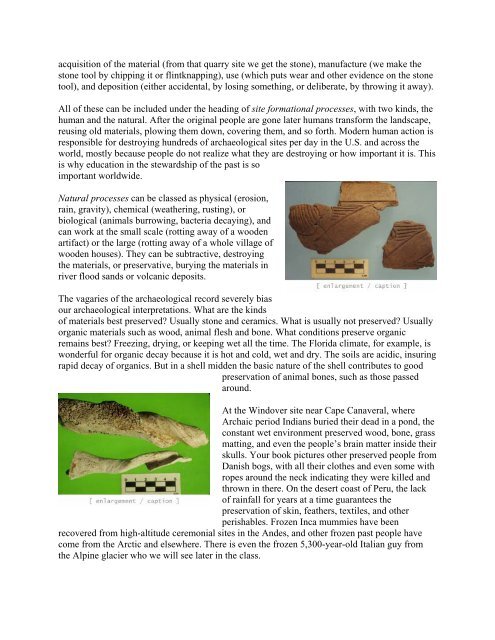INTRODUCTION TO ARCHAEOLOGY Nancy White - Touro Institute
INTRODUCTION TO ARCHAEOLOGY Nancy White - Touro Institute
INTRODUCTION TO ARCHAEOLOGY Nancy White - Touro Institute
Create successful ePaper yourself
Turn your PDF publications into a flip-book with our unique Google optimized e-Paper software.
acquisition of the material (from that quarry site we get the stone), manufacture (we make the<br />
stone tool by chipping it or flintknapping), use (which puts wear and other evidence on the stone<br />
tool), and deposition (either accidental, by losing something, or deliberate, by throwing it away).<br />
All of these can be included under the heading of site formational processes, with two kinds, the<br />
human and the natural. After the original people are gone later humans transform the landscape,<br />
reusing old materials, plowing them down, covering them, and so forth. Modern human action is<br />
responsible for destroying hundreds of archaeological sites per day in the U.S. and across the<br />
world, mostly because people do not realize what they are destroying or how important it is. This<br />
is why education in the stewardship of the past is so<br />
important worldwide.<br />
Natural processes can be classed as physical (erosion,<br />
rain, gravity), chemical (weathering, rusting), or<br />
biological (animals burrowing, bacteria decaying) , and<br />
can work at the small scale (rotting away of a wooden<br />
artifact) or the large (rotting away of a whole village of<br />
wooden houses). They can be subtractive, destroying<br />
the materials, or preservative, burying the materials in<br />
river flood sands or volcanic deposits.<br />
The vagaries of the archaeological record severely bias<br />
our archaeological interpretations. What are the kinds<br />
of materials best preserved? Usually stone and ceramics. What is usually not preserved? Usually<br />
organic materials such as wood, animal flesh and bone. What conditions preserve organic<br />
remains best? Freezing, drying, or keeping wet all the time. The Florida climate, for example, is<br />
wonderful for organic decay because it is hot and cold, wet and dry. The soils are acidic, insuring<br />
rapid decay of organics. But in a shell midden the basic nature of the shell contributes to good<br />
preservation of animal bones, such as those passed<br />
around.<br />
At the Windover site near Cape Canaveral, where<br />
Archaic period Indians buried their dead in a pond, the<br />
constant wet environment preserved wood, bone, grass<br />
matting, and even the people’s brain matter inside their<br />
skulls. Your book pictures other preserved people from<br />
Danish bogs, with all their clothes and even some with<br />
ropes around the neck indicating they were killed and<br />
thrown in there. On the desert coast of Peru, the lack<br />
of rainfall for years at a time guarantees the<br />
preservation of skin, feathers, textiles, and other<br />
perishables. Frozen Inca mummies have been<br />
recovered from high-altitude ceremonial sites in the Andes, and other frozen past people have<br />
come from the Arctic and elsewhere. There is even the frozen 5,300-year-old Italian guy from<br />
the Alpine glacier who we will see later in the class.
















